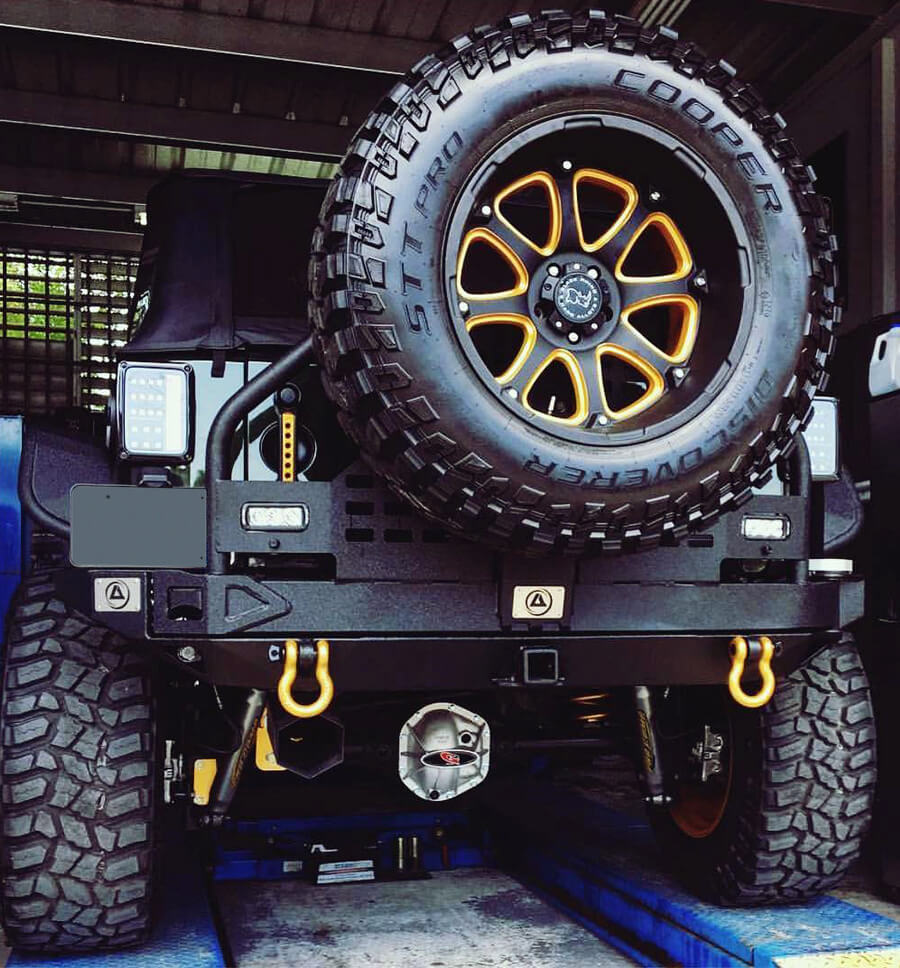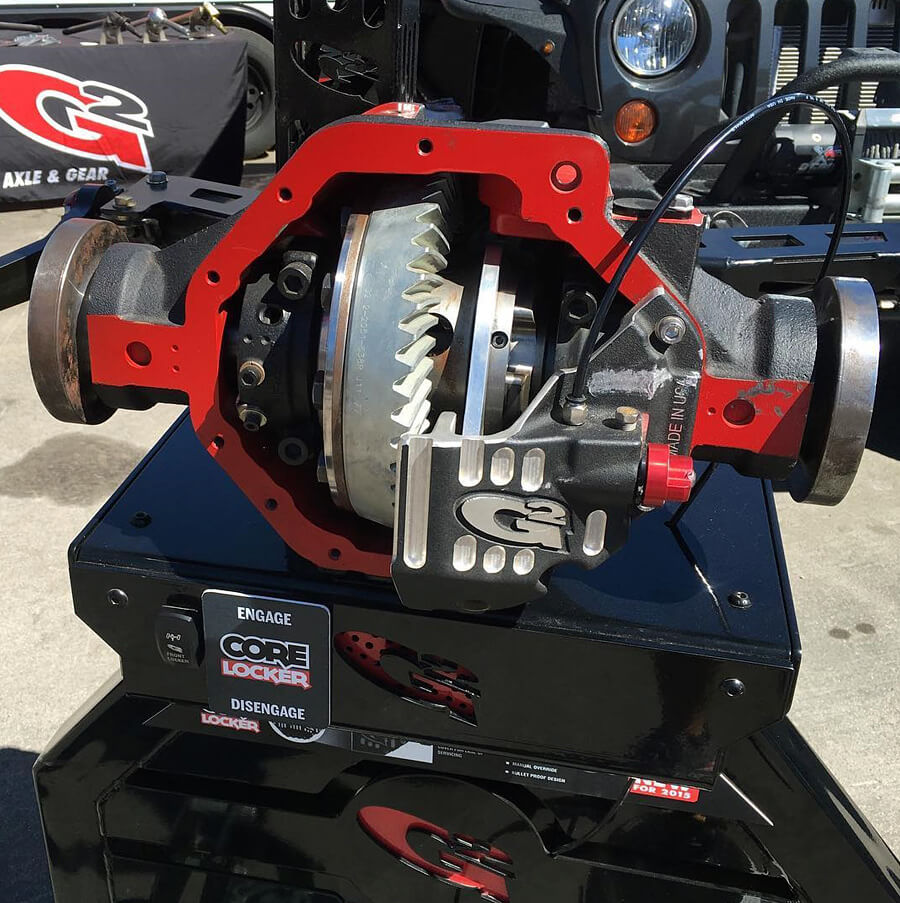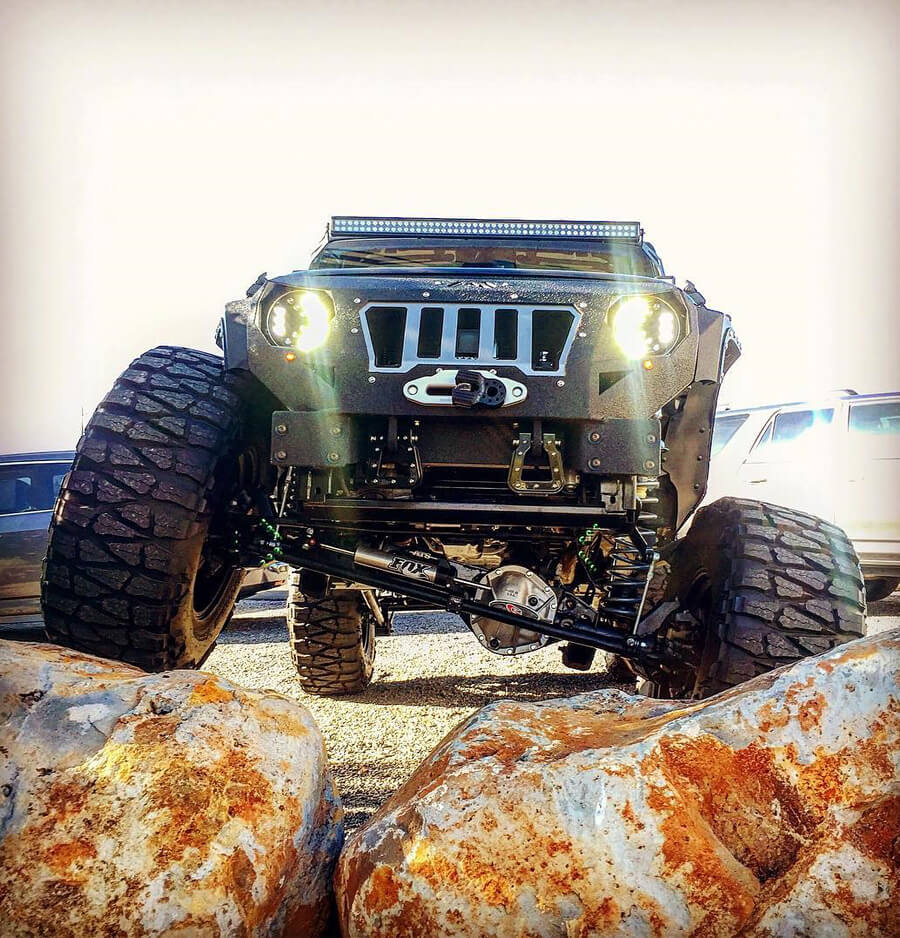Home » Product Guides » How to Determine the Rear Axle Ratio for Larger Off-Road Tires
How to Determine the Rear Axle Ratio for Larger Off-Road Tires

For truck and 4×4 owners looking to upgrade to larger, off-road tires, one critical factor to consider is the rear axle ratio. The axle ratio determines how efficiently engine power is transmitted to the wheels and can greatly impact acceleration, fuel economy, and drivability. Selecting the optimal ratio for your particular vehicle setup takes some careful calculations, but the payoff in performance can be well worth the effort.
In this post, we’ll cover everything you need to know about rear axle ratios for trucks and 4x4s. We’ll start with an overview of what the ratio is and how it affects your vehicle. Then we’ll go over methods for identifying your current ratio, along with tips for choosing the right gear ratio when upgrading your tire size or drivetrain components. We’ll also provide guidance on how to change your ratio by swapping differential gears. By the end, you’ll understand rear axle ratios and be able to optimize your truck or Jeep’s performance.
Table of Contents
ToggleHOW TO DETERMINE YOUR GEAR RATIO?
Key Takeaways for Determining Axle Ratio
- Count ring gear and pinion gear teeth to calculate ratio
- Check ratio number stamped on differential cover
- Use new tire size and old ratio to calculate new optimal ratio
- Buy ring and pinion sets designed to work together
- Lower ratios improve torque, higher ratios improve highway speed

Understanding Rear Axle Gear Ratios
The rear axle gear ratio compares the number of teeth on the ring gear to the number of teeth on the pinion gear inside the differential. It determines how much torque is multiplied and transmitted from the driveshaft to the rear wheels.
Some key points about axle ratios:
- Higher numerical ratios provide more torque multiplication and acceleration but reduce top speed
- Lower ratios allow higher speeds but less low-end torque and slower acceleration
- Factory gearing aims to balance power, drivability, and fuel economy
Dramatically increasing tire diameter with a lift kit changes the entire drivetrain equation and can cause issues if the axle ratios are not optimized for the larger tires.
Identifying Your Truck’s Current Axle Ratio
There are a few different methods you can use to identify the current gear ratio on your truck or Jeep:
Look for Ratio Number on Differential Cover
Many axle assemblies will have the gear ratio number stamped or engraved somewhere on the differential cover. This is the most straightforward way to identify the gears as long as the number is still legible.
Count Gear Teeth
If you can’t find the ratio marked on the housing, you’ll need to count the number of teeth on the ring and pinion gears inside the differential. Then divide the ring gear teeth by the pinion gear teeth to calculate the numerically ratio.
- Count the number of teeth on your pinion
- Count the number of teeth on your ring gear
- Divide the number of ring gear teeth to the number of the pinion ring teeth.
For example, you got 11 teeth on the pinion gear and 41 on the ring gear.
41 / 11 = 3.72727273 round it to two digits after the decimal point and you get 3.73
Use Part Numbers to Look Up Ratio
Another option is to locate the part or serial number stamped on the differential housing and use online resources to look up what ratio would have come with that axle assembly. The markings may be hard to find if covered in grime, so be sure to clean the housing thoroughly first.
Calculate Using Tire Diameter and Gear Count
If you can’t easily see the gear teeth to count, you can determine your current ratio by measuring the tire diameter in inches, counting the number of ring gear rotations for one full tire rotation, and plugging those variables into a gear ratio calculator.
This method isn’t as precise but can provide a reasonable estimate.
Installing tires that are significantly larger than stock will change your vehicle’s gearing ratios and can cause issues if the axle ratios are not properly matched. In most cases you can level it up using aftermarket axle gear kits that will optimize the ratio.

Choosing Best Gear Ratio for Off Roading
Once you’ve identified your current ratio, you can determine the optimal gearing for upgraded larger tires using this formula:
(New Tire Diameter x Old Ratio) / Old Tire Diameter = New Ratio
Using an example with stock 29″ tires and 3.07 gears, upgrading to 33″ tires:
(33 x 3.07) / 29 = 3.49
The closest standard ratio would be 3.55
| Tire Size Upgrade | Recommended New Ratio |
|---|---|
| 32″ | 3.55 |
| 33″ | 3.55 |
| 35″ | 3.73 |
| 37″ | 4.10 |
Some additional tips for choosing the right gear ratio:
- Consider how the vehicle will be used – higher ratios for off-roading, lower for highway
- Match the ratio to the transmission – too large a gap between gears causes issues
- Buy ring and pinion sets designed to work together, not mix-and-match
- Improper gear ratios can damage drivetrain components
THE MOST COMMON GEAR RATIOS:
- 3.07
- 3.55
- 4.10
- 4.56
- 4.88

Changing Your Truck’s Rear Differential Gear Ratio
Once you’ve determined the optimal axle ratio for your new larger tire setup, you’ll need to change out the ring and pinion gears in the differential to actually achieve that new ratio. This requires some mechanical skill and special tools.
There are a few options for swapping gear ratios:
Install a New Ring and Pinion Gear Set
Purchasing a professionally engineered ring and pinion set designed for your axle is the best way to change ratios. Gear sets are manufactured and tested as a pair to ensure quiet operation.
- Use a gear ratio calculator to determine the ideal ratio for your combo
- Purchase a gear set made specifically for your axle model
- Kits include matching ring gear, pinion gear, bearings, shims, and hardware
- Installation requires a hydraulic press for gear setup and backlash
Use an Aftermarket Differential Cover
Some companies like TeraFlex offer heavy-duty differential covers with built-in provisions for changing ratios by inserting different carrier bearings. This allows you to swap pinion gears without fully disassembling the axle.
- Covers available for Dana 44, Dana 60, Ford 9”, and GM 14 bolt axles
- Offered with 4.56, 4.88, 5.13 and 5.38 ratios
- Allows swapping ratios without a full rebuild
Buy a Pre-Built Third Member Case
You can avoid the installation work by purchasing a complete third member case and differential already set up with your desired gear ratio. These cases can be swapped into the axle housing in place of your existing third member.
- Aftermarket cases built with improved materials and ratios
- Pre-adjusted ring and pinion sets professionally installed
- Case swaps easier than rebuild but still requires some labor
Warnings!
- Don’t mix ring and pinion components from different gear sets
- Improper setup can cause accelerated wear and damage
- Ensure proper gear backlash and tooth contact pattern
- Incorrect shimming can also lead to noise and premature failure
Taking the time to properly determine your optimal axle ratio and install matched ring and pinion gears will maximize your truck’s performance with upgraded tires and avoid driveline damage. Consult a professional if unsure about taking on an axle gear swap yourself.
Expert Advice
Having spent decades modifying and wheeling trucks, I’ve learned a ton about axle ratios and gearing the hard way. There’s no question that properly matching your differential gears to bigger tires is critical. Take the time to accurately identify your current ratio before swapping parts. Counting gear teeth or decoding the markings is better than guessing based on tire size. When upgrading, use the formula provided to calculate your ideal new ratio. Close doesn’t cut it – get as near as possible to optimized. Factory engineered ring and pinion sets are worth the money, don’t mix and match. If swapping gears yourself, take meticulous measurements, follow the shop manual, and don’t skip on the precise shimming and setup. Consider a differential cover upgrade to make future changes simpler. I’ve saved money doing my own work but don’t recommend it for everyone. At minimum have an experienced driveline shop verify your setup. Improperly installed gears fail quickly and can damage other components. Optimizing your axle ratios will improve drivability and maximize your truck’s capabilities. It’s a challenging but very rewarding process. Take your time and do it right.
Matt Grabli – Editor at Offroadium
Conclusion
Properly determining your rear axle gear ratio and selecting the optimal ratio when upgrading to larger tires is critical for maintaining proper driveline function and vehicle performance. Take the time to accurately identify your current ratio, calculate the ideal new ratio, and install a matched ring and pinion set precisely. Improper gearing after a tire upgrade can lead to transmission and driveline damage. For more tips on upgrading your truck or off-road vehicle, check out our other technical articles dedicated to off-road performance modifications and enhancements. With the right gear ratios and a properly engineered lift kit, you can maximize your vehicle’s off-road traction and capabilities.
Matt is a professional mechanic, experienced off-roader, writer and founder of Offroadium. With over 15 years immersed in the off-road community and 100,000+ miles logged on rugged trails across the Americas, Grabli shares extensive real-world knowledge. He previously worked as an automotive technician before shifting focus to specialty off-road projects. His passion is prepping capable rigs for off-roading and helping others to build the 4x4s of their dreams.


Very well written, thanks for posting this!